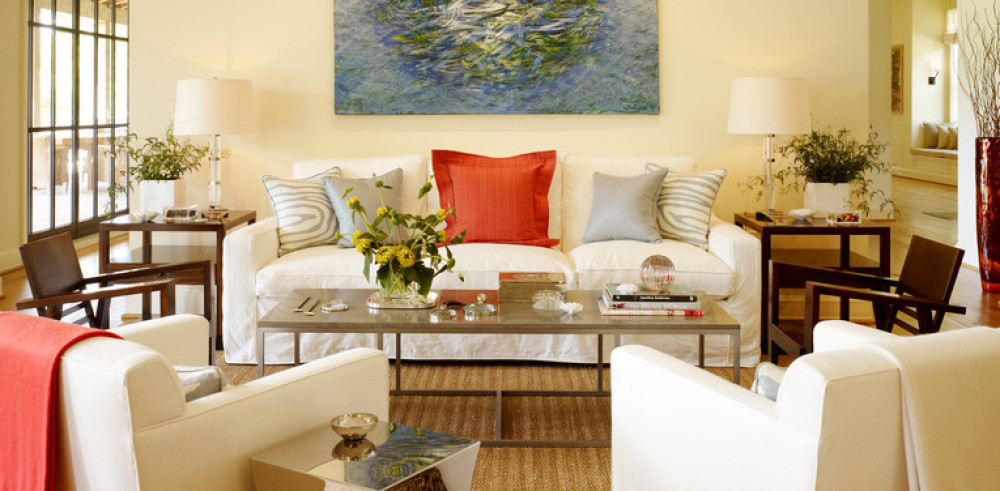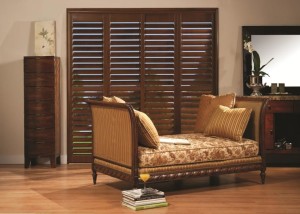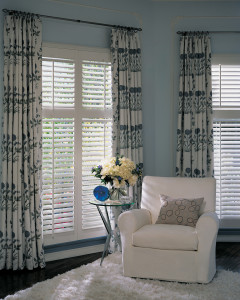California, Wooden, Plantation Shutters – whatever you want to call them, they are a stunning addition to windows.

Windows are considered the eyes of your home. Just as it is important to pick the right style of windows for your home, it is just as important to consider how you will dress those windows.
Shutters are a cost-effective way to add beauty and value to your home. They are great for controlling light, ventilation and privacy. They form a wonderful first layer of privacy when dressing a window. Draperies and other soft window treatments can be added to soften the look of your shutters if desired, which adds and even richer more luxurious touch. Great looking and quality made shutters become an architectural element to your home, which may add resale value. While the upfront cost of shutters may be more than blinds and other types of hard treatments, shutters are more durable, timeless and a better value for your home for the long term.
Although shutters were originall used for exteriors to help cool down the home in warmer climates, they have definitely moved indoors and are in high demand now-a-days.
Shutters are manufactured with different types of materials – the most common being solid wood and composite wood. How can you determine which is better for your windows? Here is a list of pros and Cons for each type of shutter.
Solid Wood Shutters
Solid wood painted shutters are the lightest in weight which helps in operation. Solid wood shutters are typically around half the weight of their composite counterparts.
• Solid wood painted shutters are available in any finish. From white to black and everywhere in-between.
• Solid wood painted (and stained) shutters are the longest lasting shutters. In many applications, solid wood shutters will offer good service for decades. Often, solid wood shutters will last as long as the house.
• Solid wood shutters have the most solid feel. The natural ridged materials of wood provide solid, twist free operation when opening and closing.
• Solid wood shutters are available in the widest array of sizes. Wider panels, taller panels and panels without additional support components (such as divider rails) are available in solid wood.
• Solid wood shutters are available in a variety of shapes – arched, round etc
Wood does however have a few cons.
• Solid wood painted shutters are not recommended in areas where the shutters are going to be subject to direct and repetitive contact with water. Not the occasional steam in a bathroom but rather direct water drops you would find in a bathroom shower surround or glass-less window. Even though the wood itself is perfectly suited for high water areas, the fact that wood swells to absorb and then contracts as it expels water, the paint on top of the wood cannot expand and contract as well. Paint will chip and peal when used in the incorrect environment.
• Wood takes longer to construct. There is a large amount of hand finishing and multiple construction steps associated with solid wood shutters. Typical wood shutters can take anywhere from four to eight (or more in certain specialty applications) to construct.
Solid wood stained shutters.
• Stained shutters offer all the same pros and cons as their painted counterparts with the exception that stained shutters come in stained finishes. With stained shutters, various woods can be used including basswood, maple, poplar, oak, cherry, maple, mahogany, and teak (which is an environmentally friendly option). Although specialty woods add to the cost of shutters, nothing provides a perfect color, finish and feel than an exact wood species match when appropriate. Stained shutters are most expensive than painted shutters.
Composite shutters.
Composite shutters are produced more quickly than wood shutters. Composite shutters can be made within two to three weeks in most applications.
Composite shutters are impervious to water making them the perfect choice for shower and bath surrounds and windows without glass.
Composite shutter cons.
• Composite shutters are heavier than solid wood shutters.
• Composite shutters are not as stiff as their solid wood counter parts. Materials such as wood and aluminum are often added inside of the composite parts to help stiffen and support composite shutters.
• Composite shutters require divider rails, center frame posts and are limited in panel width and configurations due to weight and stiffness restrictions.
• Composite shutters are available in solid colors only. Since there is not a “grain” in composite materials, there would not be a reason to stain the material. In addition, the process of staining requires an absorbent material to adhere the finish. Composite materials do not provide this material characteristic.
Interior shutters are a wonderful investment to any home. The quality of construction will vary from company to company, so a bit of research should be done before selecting a company for your shutters. Casa Vilora Interiors and No Naked Windows offer a wonderful range through Hunter Douglas and Norman. You can click here to send us an email with any questions.
Please don’t forget to comment and share! ![]()
Be Inspired!





I like the look of either one! We used to have these in our rooms as kids.
Great information, once again! We have solid wood shutters, and we love them!
Real is best!!
I am currently in the market to replace our window coverings… I’m not in a hurry since I still have a couple of 8 year olds living here, but the cord rotted inside my blinds over the winter, and now I have to either restring or replace… they’re old and not my style so I’m hoping to replace. Thanks so much for this post! It was so helpful!!!
You’re very welcome Loretta. With shutters you won’t have to worry about cords, that might be a good choice for you when you are ready.
Love your work, can’t wait until I have the opportunity to call you for your services,
Thanks for sharing with us!!
Thanks Maria, looking forward to that call oneday!
I like both but hardwood is my favorite
I like the solid wood much better
Thank you this information.
You always provide great information. One thing people might want to consider with the composite wood shutters is what they are made from, especially. people with multiple allergies.
Love the look of the shutters, not really a good look for our log cabin but will be nice when we finally get moved to Cape Coral:)
Is there one choice that is safer than another or more eco friendly?
Shutters are much safer than blinds because they don’t use the cord operation….therefore no risk of strangulation to young kids or pets. The wood shutters are made from wood harvested from sustainable forests, so they are eco-friendly
I love the way the solid wood shutters look. Thy give a welcoming feel to a home:)
Great info. To me, the composite ones look much lighter and cleaner and fresher for some reason
I love those windows in the top picture.
I prefer the wood, but they are all beautiful.
Thank you all very much for your kind comments!
You always give great content and the photos add value to your words. I have always loved shutters. Thanks for telling us about the different kinds. I had no idea there was so many different kinds.
I’m now a bit more enlightened on women’s decor’ – thanks!
I love your work that you share with us. I love the wood blinds and now that my last child is moving out, I can now have in my house, what I want
Love the wood blinds!!!
Oh Veronica, you’re a real master of interior design. I must bookmark your blog or subscribe to your RSS feed so I can always share this to everyone. I’ll pin to Pinterest your images above in my ‘Interior design’ board.
Oh I’ve always wanted shutters in my house and these make me want them even more! Such an informative article, thank you
Thanks for this, i love the different styles, a simple change which freshens the look and feel of any house.